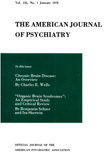The Speech of a Schizophrenic Child from Two to Six
Abstract
The language development of a schizophrenic child was systematically observed from ages two to six. While the child attained increasing intelligibility and a normal score on a test of language development, finer analysis revealed a severe impairment of communicativeness. The changing relationship between the amounts of echoing and context disturbance in this child's noncommunicative speech indicates that speech can serve as a revealing index of pathology. His communicative speech was marked by rigidity and only limited use of tenses and transformations. The authors believe these rigidities are related to structural defects in integration and identification.
Access content
To read the fulltext, please use one of the options below to sign in or purchase access.- Personal login
- Institutional Login
- Sign in via OpenAthens
- Register for access
-
Please login/register if you wish to pair your device and check access availability.
Not a subscriber?
PsychiatryOnline subscription options offer access to the DSM-5 library, books, journals, CME, and patient resources. This all-in-one virtual library provides psychiatrists and mental health professionals with key resources for diagnosis, treatment, research, and professional development.
Need more help? PsychiatryOnline Customer Service may be reached by emailing [email protected] or by calling 800-368-5777 (in the U.S.) or 703-907-7322 (outside the U.S.).



